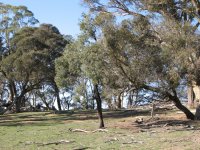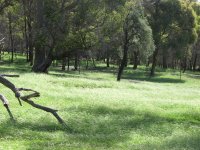The Old Ram-Australia
Herd Master
- Joined
- Jan 18, 2011
- Messages
- 978
- Reaction score
- 2,066
- Points
- 303
Recently I coined the phrase,” Make the livestock fit the landscape, not the landscape fit the livestock”.
I used the phrase in an article or two and it seems to have “struck a cord” with a number of people going by the responses I have received.
We have had our current farm for 20 + years now, its 300 acs and for the first 10 we followed traditional practices with regard to our livestock production methods, but by 2008 it was oblivious that it was all falling apart and so began a search for a method of production which was not only envirinonmentally sensitive but sustainable and resulted in a profit outcome.
Before we started additional fencing to produce more paddocks I looked at the landscape and this is what I found. In round numbers 40% of our farm is north facing, 40% is South facing and 20% is west facing. The West facing presents the largest challenge because the “worst” of our weather be it hot or cold comes from this direction .There are periods in both spring and autumn when it is the most “favorable” place for stock to be .In the summer we have a large stand of Cottonwoods below a spring which fills a dam below. The new flocks graze with “glee” the emerging growth in the spring and rest in the cool shade in the hottest part of summer. This winter we have had what I would describe as a pretty strong group of Wiltshire Horns and W.H. Dorpers to test whether they are up to the challenge they are all in lamb to begin mid/late August (so far so good, end July).So far they have been exposed to wind (almost 100km per hr) and frost (around -6 c on several occasions) without any visible signs of ill-effect.
The north facing although the hottest in the summer are not subjected to the winds and is fenced in a way to provide woodland shelter in each of the paddocks it was also the most effected by “poor management” when we purchased the farm almost 20 years later it ranks very favorably with any of our other sloping areas in production value.
The areas south facing are our coolest summer paddocks and are about 50% Woodland grazing and are favored night grazing in the summer months while providing cool grazing during the heat of the day.
Water management is a major priority on the farm, but it took me years of observation to understand just how our system works. The catchment for our creek is about 400acs about half is south facing and the other north facing. In the case of the south facing about 80% of the rainfall is carried “through the profile” due( IMO )to the effect of the old growth woodland which presents a “soft landing” for the rain as it falls to the ground. Whereas on the other slope about 80% is delivered across the surface (well that’s how it used to be) but over the past 10 or so years we have reduced this to about 50/50 by allowing woodland regeneration on the highest parts of our farm and using in the correct manner the “swales” which were installed about 40 years ago, but were never managed in the way they were designed.
Our creek is in effect a erosion gully(A river when it rains) which used to carry a large volume of water during a rain event and over time scoured out the bed and produced the wide ,quite deep gully we have today. In the years since we started the works have affected the volume and the speed at which the surface water reaches the creek proper and in effect by the time the water from the highest parts reach the creek most of the water from the lower sections has already passed through the system.
It has now been about 2 years since we started to transition from British Shortwools (English Suffolk’s) to as many Hair breeds as we can muster to begin the path to a new Composite which will “fit” our changing local environment and management style (which is as little interference as possible).This change is also the start of a new learning curve for the management of the different breeds which will ultimately make up the new flock.
NOTE: if you are in the Northern Hemisphere the aspects will be opposite to Downunder so take this into a/c when reading the post......T.O.R.
I used the phrase in an article or two and it seems to have “struck a cord” with a number of people going by the responses I have received.
We have had our current farm for 20 + years now, its 300 acs and for the first 10 we followed traditional practices with regard to our livestock production methods, but by 2008 it was oblivious that it was all falling apart and so began a search for a method of production which was not only envirinonmentally sensitive but sustainable and resulted in a profit outcome.
Before we started additional fencing to produce more paddocks I looked at the landscape and this is what I found. In round numbers 40% of our farm is north facing, 40% is South facing and 20% is west facing. The West facing presents the largest challenge because the “worst” of our weather be it hot or cold comes from this direction .There are periods in both spring and autumn when it is the most “favorable” place for stock to be .In the summer we have a large stand of Cottonwoods below a spring which fills a dam below. The new flocks graze with “glee” the emerging growth in the spring and rest in the cool shade in the hottest part of summer. This winter we have had what I would describe as a pretty strong group of Wiltshire Horns and W.H. Dorpers to test whether they are up to the challenge they are all in lamb to begin mid/late August (so far so good, end July).So far they have been exposed to wind (almost 100km per hr) and frost (around -6 c on several occasions) without any visible signs of ill-effect.
The north facing although the hottest in the summer are not subjected to the winds and is fenced in a way to provide woodland shelter in each of the paddocks it was also the most effected by “poor management” when we purchased the farm almost 20 years later it ranks very favorably with any of our other sloping areas in production value.
The areas south facing are our coolest summer paddocks and are about 50% Woodland grazing and are favored night grazing in the summer months while providing cool grazing during the heat of the day.
Water management is a major priority on the farm, but it took me years of observation to understand just how our system works. The catchment for our creek is about 400acs about half is south facing and the other north facing. In the case of the south facing about 80% of the rainfall is carried “through the profile” due( IMO )to the effect of the old growth woodland which presents a “soft landing” for the rain as it falls to the ground. Whereas on the other slope about 80% is delivered across the surface (well that’s how it used to be) but over the past 10 or so years we have reduced this to about 50/50 by allowing woodland regeneration on the highest parts of our farm and using in the correct manner the “swales” which were installed about 40 years ago, but were never managed in the way they were designed.
Our creek is in effect a erosion gully(A river when it rains) which used to carry a large volume of water during a rain event and over time scoured out the bed and produced the wide ,quite deep gully we have today. In the years since we started the works have affected the volume and the speed at which the surface water reaches the creek proper and in effect by the time the water from the highest parts reach the creek most of the water from the lower sections has already passed through the system.
It has now been about 2 years since we started to transition from British Shortwools (English Suffolk’s) to as many Hair breeds as we can muster to begin the path to a new Composite which will “fit” our changing local environment and management style (which is as little interference as possible).This change is also the start of a new learning curve for the management of the different breeds which will ultimately make up the new flock.
NOTE: if you are in the Northern Hemisphere the aspects will be opposite to Downunder so take this into a/c when reading the post......T.O.R.



 e results of the change of breds within the livestock type will not become evident for about 5 years i suspect.That change was driven by Jenny's Alzheimer's and my advancing years.To the first:1. Grazing management 2.Understanding the "history " of the landscape,how it was born ,the changes since "white man" came and the changes in the last 50 years,but only a brief outline is needed ,not an "academic" undertaking.3.How water interacts with landscape,ie: how it helps and how it degrades.4.Recording what it happening over time and at the start of a year looking back over however many years of records you have and" ask" is the landscape better now or worse?The best tool you can have is a small camera which records the same spot in every paddock every month of the year and ask your self was the outcome better and if not, what contributed to the result? in the case of worse "is it the worse recorded"? Ask your self what were the factors which contributed to the outcome,"lack of rain","to many stock" or even some of the decisions you made along the way?
e results of the change of breds within the livestock type will not become evident for about 5 years i suspect.That change was driven by Jenny's Alzheimer's and my advancing years.To the first:1. Grazing management 2.Understanding the "history " of the landscape,how it was born ,the changes since "white man" came and the changes in the last 50 years,but only a brief outline is needed ,not an "academic" undertaking.3.How water interacts with landscape,ie: how it helps and how it degrades.4.Recording what it happening over time and at the start of a year looking back over however many years of records you have and" ask" is the landscape better now or worse?The best tool you can have is a small camera which records the same spot in every paddock every month of the year and ask your self was the outcome better and if not, what contributed to the result? in the case of worse "is it the worse recorded"? Ask your self what were the factors which contributed to the outcome,"lack of rain","to many stock" or even some of the decisions you made along the way?